|
Pompeii, perhaps one of the most famous
of Roman cities, was a busy trading centre near present day
Naples.On 24 August 79 CE (or AD, if you prefer) it was engulfed by
gas and falling ash from the massive volcanic eruption of nearby Mt
Vesuvius. (Photos by Mike Freedman) |
 |
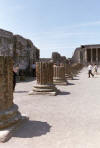 |
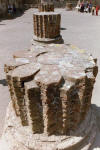 |
 |
 |
|
Near the forum, stands the Temple of
Jupiter, chief of the Roman gods. Behind it, in the haze, looms the
bulk of Mount Vesuvius. |
The Basilica, or courthouse, in Pompeii
had been damaged in an earthquake some years before the eruption of
79 CE. It was being rebuilt by gangs of workmen. Each gang had their
own column. They had all reached about the same height when work was
interrupted... |
One of the columns in the Basilica
clearly shows the construction method. Leaf shaped tiles were set
around a central core. The tiles were offset between one layer and
the next (rather like bricks in a wall are). Small pieces were
inserted to complete the fluted shape. |
This mosaic floor in the gateway of a
Pompeii villa is a picture of a dog with the warning CAVE CANUM (Beware
of the dog). |
Pompeii had several public performance
spaces. This is the small theatre, or Odeon, which was a venue for
musical events. Without efficient artificial lighting performances
took place during the hours of daylight. The whole arena could be
covered with a fabric roof to protect the audience from the hot sun
(or the rain). |
|
155Kb |
45Kb |
89Kb |
171Kb |
210Kb |
|
Top |
 |
 |
 |
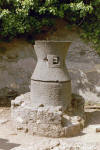 |
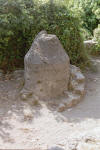 |
|
The large theatre in Pompeii is still
occasionally used for performances today. The ironwork, clearly
visible in this photo provides fixings for the seating and the
stage. |
Pompeii was built on the side of a hill.
Every house had a supply of piped water but there was no sewage
system. Sewage and other household water was simply emptied into the
street which, according to our guide, were constantly running with
water. The pedestrian walkways are high and each street had stepping
stones to let people get across! |
Deep ruts in the surface of the road
show the result of many years of traffic. From the look of it the
carts that used this street must have been built to a standard wheel
span. |
Two flour mills - one incomplete, seen
in one of the bakery shops in Pompeii. Grain was ground into flour
when two slaves turned the top half, capstan-style. |
|
219Kb |
208Kb |
191Kb |
214Kb |
201kb |
|
Top |
|
Paestum, near Salerno in southern Italy,
is the site of the Greek colony of Poseidonia. It was later occupied
by Romans. The site has been extensively excavated. Three Greek
temples still stand on the site, together with many other Greek and
Roman remains. (Photos by Mike Freedman) |
 |
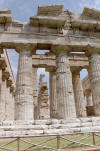 |
 |
 |
 |
|
The smallest of the 3 temples is
dedicated to sown on some plans as the temple of Ceres, on others as
the temple of Athena. |
From the front of the larger Temple of
Poseidon you can see the remains of the internal walls and columns. |
The Temple of Poseidon in the
background, the more delicate temple of Hera in the foreground. |
The underside of the arched entrance to
the Roman amphitheatre. The inside of the arch would probably have
been rendered. |
The Greek ekklesiasterion was the
council meeting arena. Being seated around a circular arena nobody
was at the front. |
|
77Kb |
101Kb |
48Kb |
103Kb |
112Kb |
|
Top |
|
For photos of buildings in Ephesus see our
Architecture Page. |